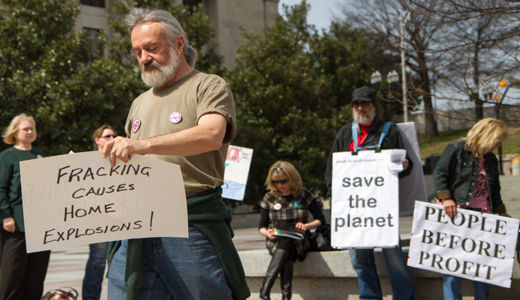
Residents of central Oklahoma are enduring what they describe as a swarm of earthquakes that have shaken their homes and rattled their nerves. Not far from there, fracking operations are ongoing, continuously disturbing both the environment and people’s peace of mind.
On July 24, about 500 people in the Oklahoma town of Edmonton attended a meeting with regulators and research geologists in order to voice their concerns. They have noticed the increasing frequency of quakes in an area that used to have no seismic activity at all. It is no coincidence, they believe, that the central part of the state is home to many fracking wastewater disposal wells.
Scientists say the injection of wastewater into the ground could be triggering manmade earthquakes. Fracking involves blasting water, sand, and chemicals into underground rock formations to bring oil and gas to the surface. They believe that fluid then increases pressure beneath the ground and helps to lubricate faults, encouraging seismic disturbances. Pumping that waste into the earth at high pressure, they add, doesn’t help matters.
“I’ve experienced dozens, maybe a hundred, earthquakes,” said Edmonton resident Mary Fleming, who noted they shake her house periodically and cause cracks in the plaster inside her home. “The house rocks. The bed lurches.” She was one of the many who raised their hands when residents were asked whether a recent tremor jolted them awake early in the morning.
The citizens urged the Oklahoma Corporation Commission, which regulates the oil and gas industries, to ban or severely restrict the wastewater wells, which have likely contributed to most of the 230 quakes the state has recorded so far this year. Two days after this meeting, in fact, a magnitude 3.6 earthquake was recorded southwest of the town of Guthrie by the U.S. Geological Survey; that’s not a high enough magnitude to cause major damage, but it’s certainly not a microquake, either.
Austin Holland, a research seismologist with the U.S. Geological Survey, remarked, “This state is experiencing an unprecedented level of earthquake activity.” He said the agency is closely monitoring the quakes to see if they worsen, and furthermore to determine conclusively whether they are being caused by fracking. “We’re having more earthquakes here, including magnitude three, than the western U.S.” He admitted, “We do see some cases where there is a pretty clear link between fluid injection and the earthquakes.”
Another possibility, he thought, is that this is due to a combination of human-caused and natural effects; perhaps even a perfect storm of factors. “We can tell that sometimes very large rainfalls or changes in aquifer levels can cause earthquakes. Just the natural changes that occur. We could be looking at a combination of that, combined with changes in the amount of wastewater that is disposed of, and natural stress changes. There are all sorts of different [possible circumstances] that we are looking at.”
William Ellsworth, a geophysicist with the U.S. Geological Survey who has published more than 100 papers on earthquakes, said the worst part is that, even after scientists have established a link between seismic activity and fracking, no state besides Ohio factors this into its drilling operations. In 49 states, there is no seismic risk assessment required for injection wells. “Nobody is talking to one another about this,” he said. “I’m worried that one day, an injection of wastewater into the ground could pierce an unknown fault somewhere that’s five miles from a nuclear power plant.”
“This swarm of earthquakes is very robust,” said Holland. And there could be a chance that somewhere in this series of tremors, a more destructive quake could occur. “In 2011, we saw a foreshock, a bunch of earthquakes, a large main shock, and then it settled down for a couple of days.” In the same way, “it is certainly possible that we could see a large earthquake in this [current] sequence.” Either way, the current quakes show no signs of slowing. “We continue to see seismic activity in the area,” he concluded.
Photo: An anti-fracking demonstration takes place in Oklahoma, decrying the dangers of fracking. Residents of many affected towns are now ready to add “earthquakes” to that list. Erik Schelzig/AP










